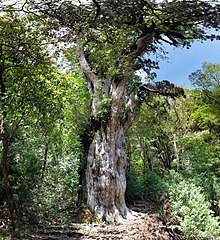30°21′40″N 130°31′55″E / 30.3610°N 130.5319°E / 30.3610; 130.5319

Jōmon Sugi (縄文杉) is a large Cryptomeria tree (yakusugi) located on Yakushima, a UNESCO World Heritage Site, in Japan. It is the oldest and largest among the old-growth cryptomeria trees on the island, and is estimated to be between 2,170 and 7,200 years old. Other estimates of the tree's age include "at least 5,000 years", "more than 6,000 years", and "up to 7,000 years old". The tree's name is a reference to the Jōmon period of Japanese prehistory.
Overview

Jōmon Sugi is located on the north face of Mount Miyanoura, the highest peak on Yakushima, at an elevation of 1,300 m (4,300 ft). Discovery of the tree in 1968 "sparked moves to protect the forests" of Yakushima and gave rise to the island's tourist industry, which today comprises more than half of its economy.
Jōmon Sugi is accessible via the Kusugawa Hiking Path (east of Miyanoura) and the Arakawa Trail (starting at the Arakawa Dam), but requires a "four-to-five hour mountain hike" from the nearest road to reach. After the designation of Yakushima as a World Heritage Site in 1993, local officials restricted access to the tree to an observation deck built at a distance of 15 m (49 ft) from the tree.
The tree has a height of 25.3 m (83 ft) and a trunk circumference of 16.4 m (54 ft). It has a volume of approximately 300 m (11,000 cu ft), making it the largest conifer in Japan. Tree-ring dating conducted by Japanese scientists on the tree's branches indicated that Jōmon Sugi is at least 2,000 years old. In Remarkable Trees of the World (2002), arborist Thomas Pakenham describes Jōmon Sugi as "a grim titan of a tree, rising from the spongy ground more like rock than timber, his vast muscular arms extended above the tangle of young cedars and camphor trees".
In 2005, vandals stripped from the tree a piece of bark measuring about 10 cm (4 in) on each side.
In April 2009, Jōmon Sugi was partnered with Tāne Mahuta in New Zealand's Waipoua Forest.
See also
References
- ^ Pakenham, Thomas (2003). Remarkable Trees of the World. W. W. Norton & Company. p. 51. ISBN 978-0-393-32529-4.
- ^ "Vandals damage Japan's World Heritage tree". UPI NewsTrack. 2005-05-25. Retrieved 2008-08-25.
- English, Andrew (2006-04-15). "Hydrogen island". The Daily Telegraph. Archived from the original on April 21, 2013. Retrieved 2008-08-25.
- Yamaguchi, H.; Nishio, S. (1995). "Water surrounding Jomon-sugi, a mysterious cedar tree growing in Yakushima Island for 7200 years". Journal of the Japan Society of Civil Engineers (in Japanese). 80: 86–89. ISSN 0021-468X.
- Elsey, Teresa, ed. (December 2003). Let's Go Japan (1st ed.). Macmillan. p. 634. ISBN 978-0-312-32007-2.
- Kanagy, Ruth (2004). Living Abroad in Japan. Avalon Travel Publishing. p. 11. ISBN 978-1-56691-672-1.
- ^ Dodd, Jan; Simon Richmond (2001). The Rough Guide to Japan (2nd ed.). Rough Guides. pp. 767. ISBN 978-1-85828-699-0.
- Arnold, Wayne (2005-06-02). "A wet climb through a green wonderland". The New York Times. Retrieved 2013-09-26.
- Walder, Rebecca; Brown, Jackum; Brown, David (2006). "Asia". 501 Must-Visit Destinations. Octopus Publishing. ISBN 978-0-75372-214-5.
- Hobson, Jake (2007). Niwaki: Pruning, Training and Shaping Trees the Japanese Way. Timber Press. pp. 86. ISBN 978-0-88192-835-8.
- National Geographic atlas of the world, National Geographic Society, 2011, ISBN 9781426206344, OCLC 841668376
- Thompson, Chuck (2002). The 25 Best World War II Sites, Pacific Theater: The Ultimate Traveler's Guide to the Battlefields, Monuments & Museums. Greenline Historic Travel Series. Greenline Publications. p. 26. ISBN 978-0-9666352-6-3.
- Tsumura, Yoshihiko (2011). "Cryptomeria". In Kole, Chittaranjan (ed.). Wild Crop Relatives: Genomic and Breeding Resources: Forest Trees. Springer Berlin Heidelberg. p. 53. ISBN 978-3-642-21250-5.
- "Iconic trees in world-first partnership". Stuff.co.nz. 24 April 2009. Retrieved 2011-10-08.
External links
- Trail to Jomon cedar, Yakushima, Kagoshima-ken, image gallery